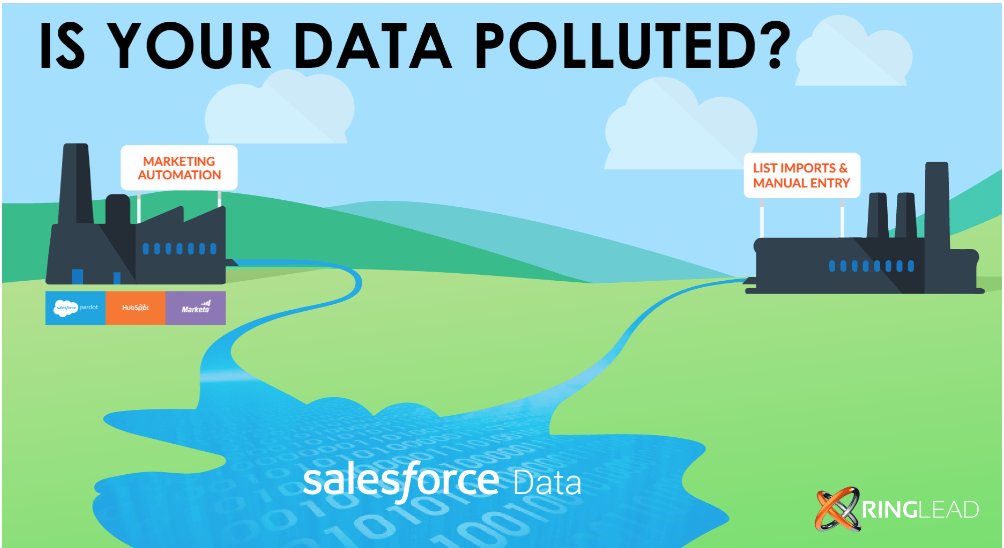
RingLead is one of many cleaning programs available to correct polluted data within AI systems. (Source: RingLead)
Your Dirty Data Can Create ‘Alternative Facts’ If It Isn’t Cleaned Up
In today’s world where nearly everything is being touched or driven by AI, it is vital that data being used is up-to-date and clean. A story on analyticsinsight.com describes five types of dirty data and fives ways to clean up files.
The article states the problems with dirty data like this:
1. Duplicate: Duplicate data is something like having a genetically similar twin who exists only to trash talk. It affects the most in different ways including data migration, through data exchanges, data integrations, and 3rd party connectors, manual entry, and batch imports. It causes inflated storage count, inefficient workflows, and data recovery. Skewed metrics and analytics, poor software adoption due to data inaccessibility, decreased ROI on CRM and marketing automation systems.
2. Outdated: Some data reports just fall into this category; visibly promising but substantially outdated. It’s almost like having no data at all or much worse. It all depends on how quickly you can identify it and do away with it. Be it the change of roles and companies by individuals, rebranded companies, or systems improvising over time, old data should never be used to draw insights into current situations.
3. Insecure: With Governments stringently applying data privacy laws and providing financial incentives for compliance, companies are quickly becoming vulnerable to insecure data. Consumer-centric mechanisms to ensure digital privacy such as digital consent, opt-ins, and privacy notifications have taken an unprecedented role in the process of putting data into some commercial or social use. GDPR in the EU, California’s Consumer Privacy Act(CCPA), and Maine’s Act to Protect the Privacy of Online Consumer Information are a few to name. For example, when an individual prefers to opt out of a company’s consumer database, not adhering to consumer data privacy policies on part of companies makes them liable for legal action. Usually, it happens because companies hoard a lot of data, and that too which is disorganized. Adhering to data privacy protection laws comes easy with the practice of having a clean database.
You get the picture that any data can become dirty data and slow everything you are trying to get done. They included Inconsistent and Incomplete data on the list as well.
Fortunately, the article includes five ways to clean up dirty data.
Data Cleaning Tools
Depending on the level a company is at in using AI, some of these tools may be familiar while others may be new. Here are three samples from the article.
1. Open Refine:
Using open refine, you can not only clean the errors but also inspect the data, amend the data and save its history. With this tool, you don’t have to test for the functionality of a particular operation. It also works for public databases which are provided in a particular form for the public to have access to that form. It enables support for reconciliation Webservices. Companies can link their datasets to the web in just a few steps. OpenRefine also facilitates support for a lot of reconciling Webservices.
2. Winpure Clean & Match:
With an intuitive user interface, it can filter, match and deduplicate data, and can be installed locally, not worrying about data security. The security feature is why it’s used to process CRM and mailing list data. Winpure’s is applicable for a wide range of databases including spreadsheets, CSVs, SQL servers to Salesforce, and Oracle. This cleaning tool comes with useful features such as fuzzy matching and rule-based programming.
5. Data Ladder:
A data cleaning tool that connects data from disparate sources like Excel, TXT files, etc, efficiently identifies errors and removes them to consolidate them into one seamless dataset. It is known for deduplication of data by checking with different statistical agencies, particularly for correcting sensitive data in healthcare and finance, thereby detecting fraud and crime. Touted as an accurate cleansing tool, it is pretty much user-friendly.
read more at analyticsinsight.net







Leave A Comment